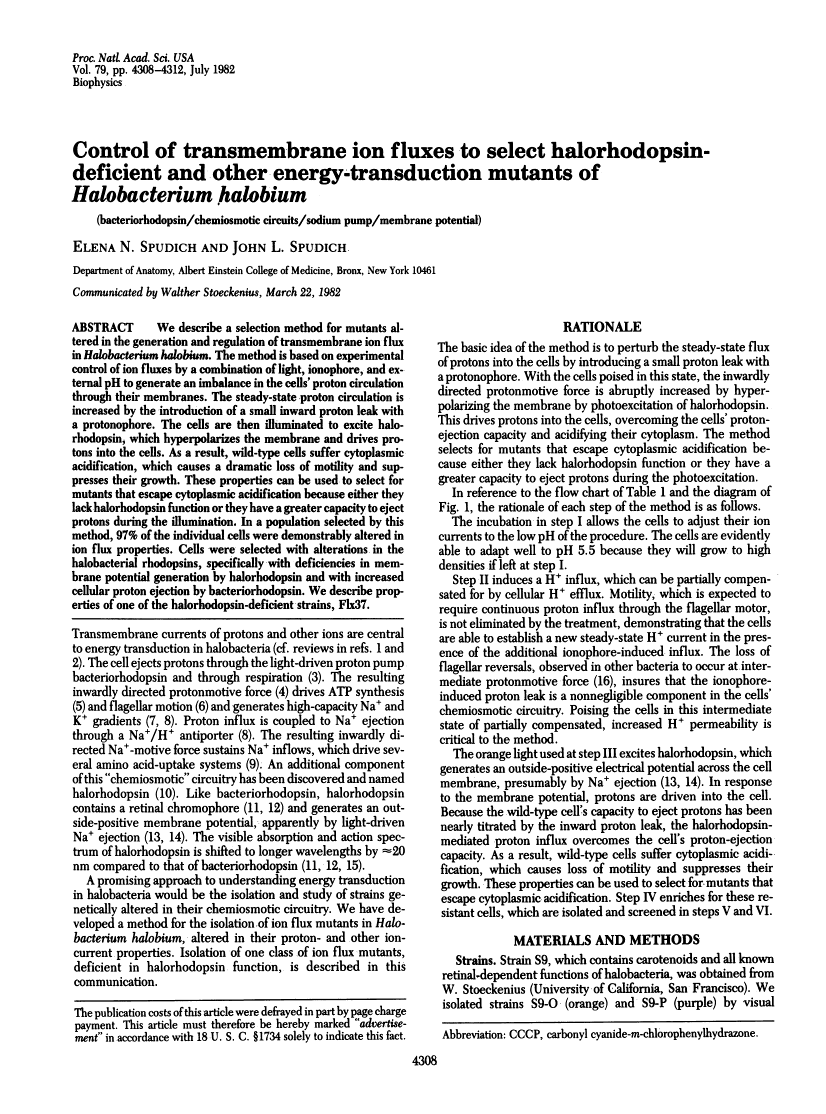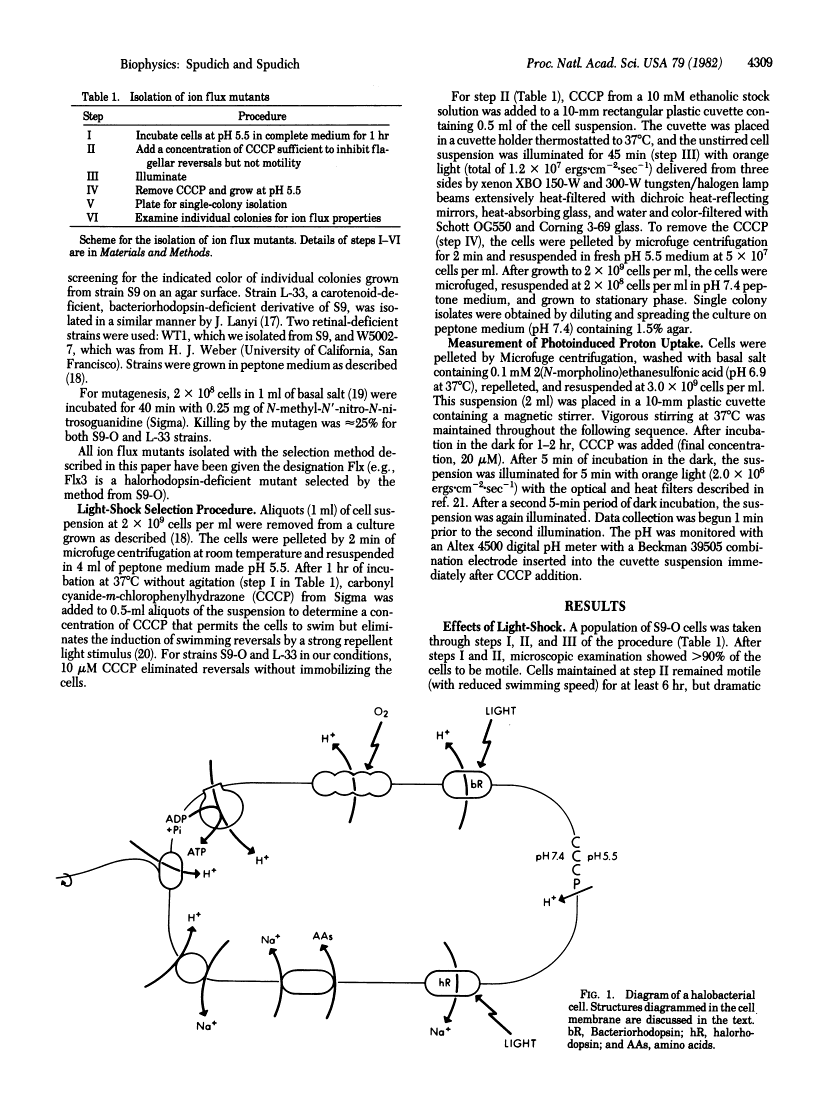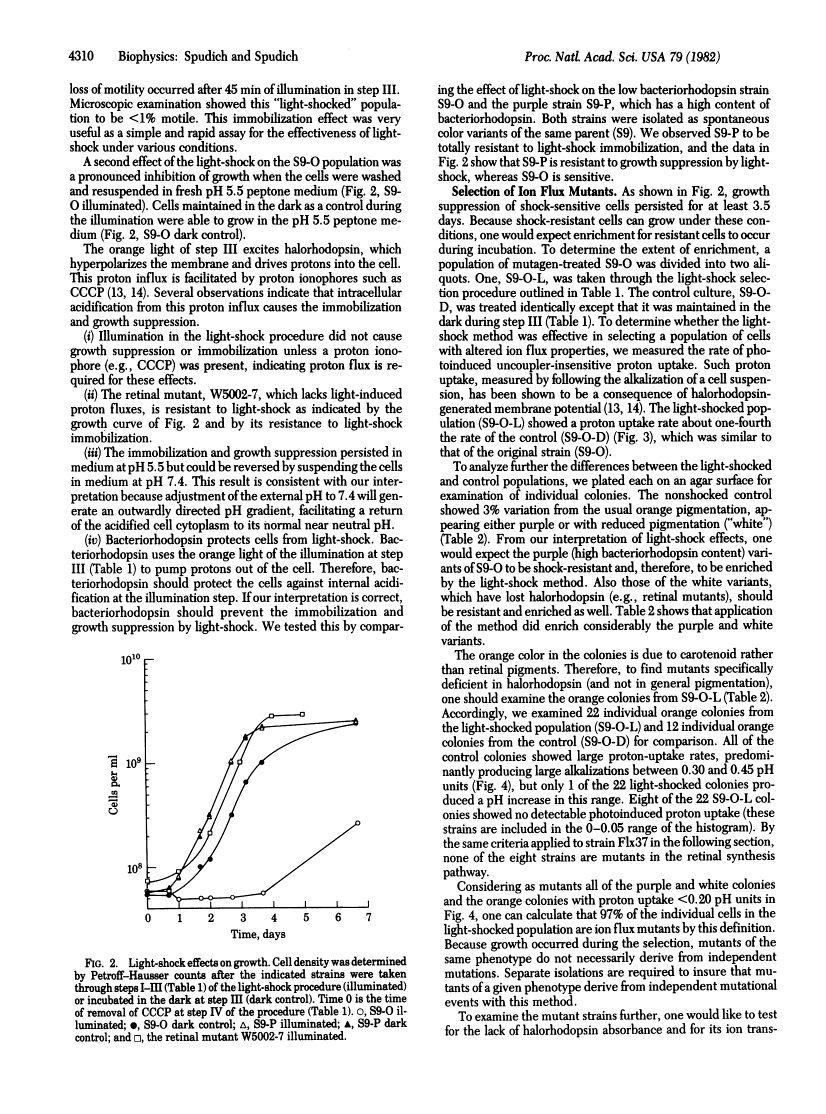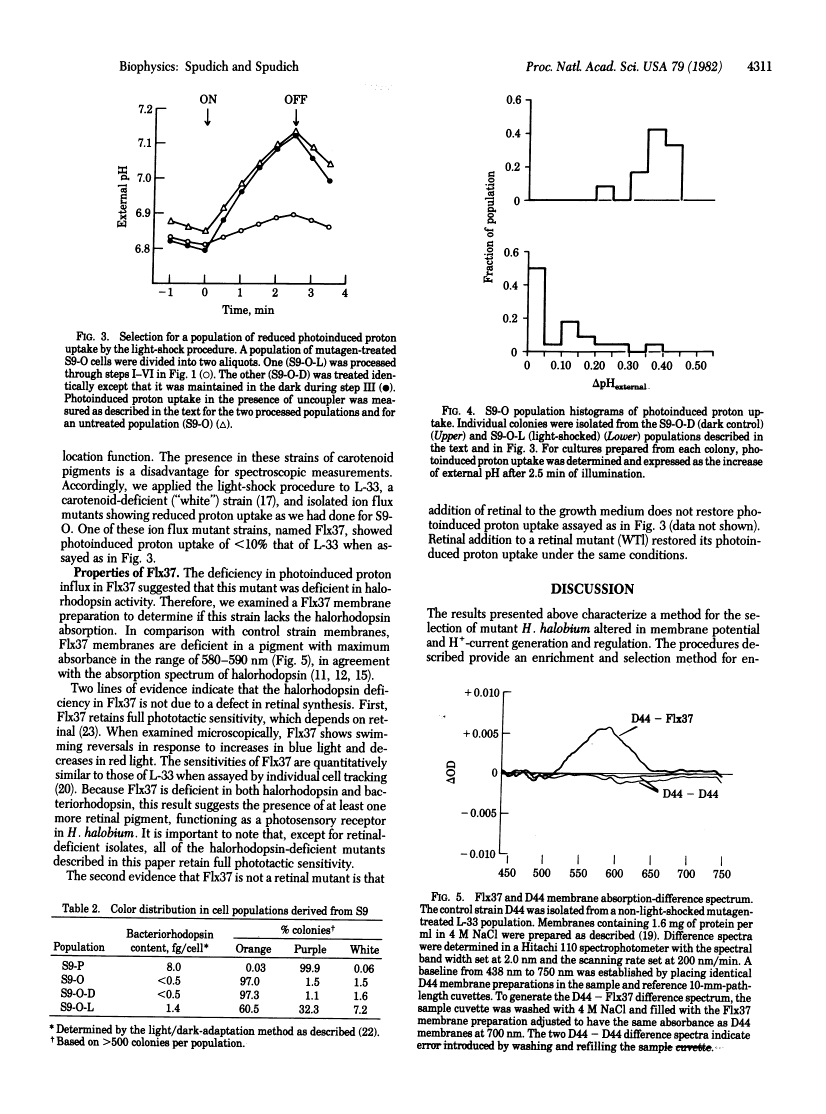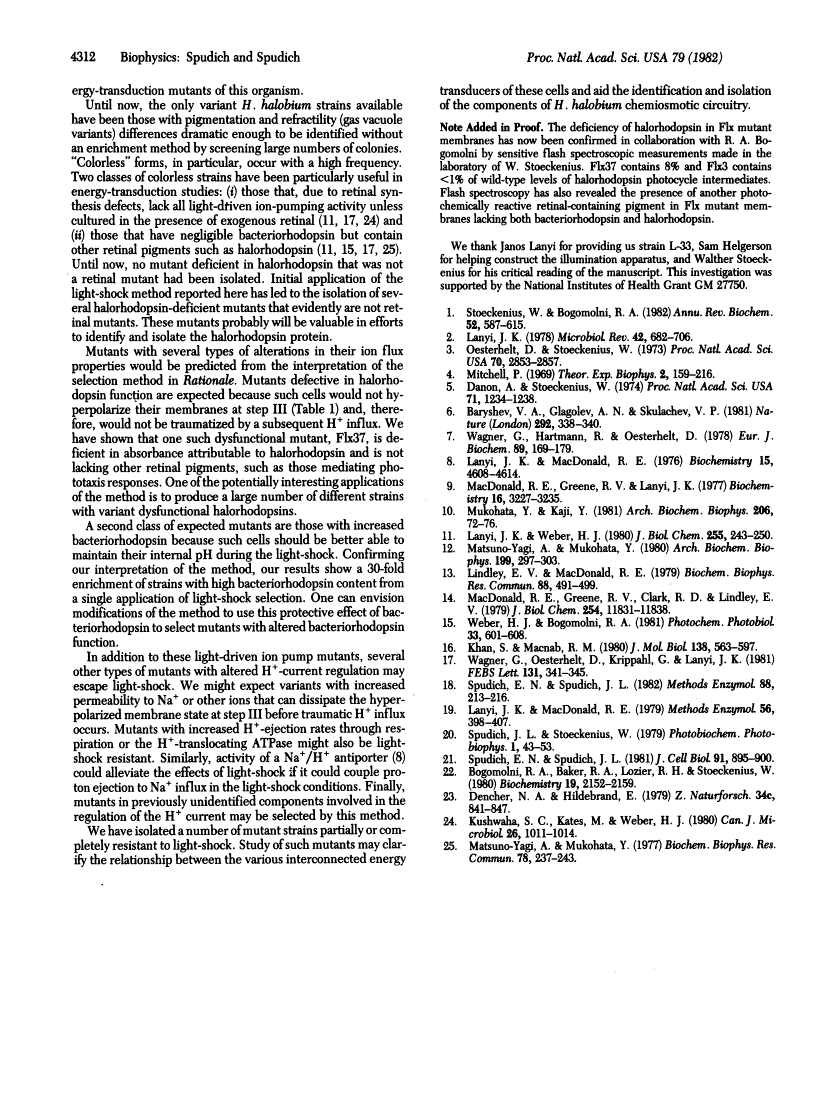Abstract
Free full text

Control of transmembrane ion fluxes to select halorhodopsin-deficient and other energy-transduction mutants of Halobacterium halobium.
Abstract
We describe a selection method for mutants altered in the generation and regulation of transmembrane ion flux in Halobacterium halobium. The method is based on experimental control of ion fluxes by a combination of light, ionophore, and external pH to generate an imbalance in the cells' proton circulation through their membranes. The steady-state proton circulation is increased by the introduction of a small inward proton leak with a protonophore. The cells are then illuminated to excite halorhodopsin, which hyperpolarizes the membrane and drives protons into the cells. As a result, wild-type cells suffer cytoplasmic acidification, which causes a dramatic loss of motility and suppresses their growth. These properties can be used to select for mutants that escape cytoplasmic acidification because either they lack halorhodopsin function or they have a greater capacity to eject protons during the illumination. In a popular selected by this method, 97% of the individual cells were demonstrably altered in ion flux properties. Cells were selected with alterations in the halobacterial rhodopsin, specifically with deficiencies in membrane potential generation by halorhodopsin and with increased cellular proton ejection by bacteriorhodopsin. We describe properties of one of the halorhodopsin-deficient strains, Flx37.
Full text
Full text is available as a scanned copy of the original print version. Get a printable copy (PDF file) of the complete article (1.0M), or click on a page image below to browse page by page. Links to PubMed are also available for Selected References.
Selected References
These references are in PubMed. This may not be the complete list of references from this article.
- Stoeckenius W, Bogomolni RA. Bacteriorhodopsin and related pigments of halobacteria. Annu Rev Biochem. 1982;51:587–616. [Abstract] [Google Scholar]
- Lanyi JK. Light energy conversion in Halobacterium halobium. Microbiol Rev. 1978 Dec;42(4):682–706. [Europe PMC free article] [Abstract] [Google Scholar]
- Oesterhelt D, Stoeckenius W. Functions of a new photoreceptor membrane. Proc Natl Acad Sci U S A. 1973 Oct;70(10):2853–2857. [Europe PMC free article] [Abstract] [Google Scholar]
- Danon A, Stoeckenius W. Photophosphorylation in Halobacterium halobium. Proc Natl Acad Sci U S A. 1974 Apr;71(4):1234–1238. [Europe PMC free article] [Abstract] [Google Scholar]
- Wagner G, Hartmann R, Oesterhelt D. Potassium uniport and ATP synthesis in Halobacterium halobium. Eur J Biochem. 1978 Aug 15;89(1):169–179. [Abstract] [Google Scholar]
- Lanyi JK, MacDonald RE. Existence of electrogenic hydrogen ion/sodium ion antiport in Halobacterium halobium cell envelope vesicles. Biochemistry. 1976 Oct 19;15(21):4608–4614. [Abstract] [Google Scholar]
- MacDonald RE, Greene RV, Lanyi JK. Light-activated amino acid transport systems in Halobacterium halobium envelope vesicles: role of chemical and electrical gradients. Biochemistry. 1977 Jul 12;16(14):3227–3235. [Abstract] [Google Scholar]
- Mukohata Y, Kaji Y. Light-induced membrane-potential increase, ATP synthesis, and proton uptake in Halobacterium halobium, R1mR catalyzed by halorhodopsin: Effects of N,N'-dicyclohexylcarbodiimide, triphenyltin chloride, and 3,5-di-tert-butyl-4-hydroxybenzylidenemalononitrile (SF6847). Arch Biochem Biophys. 1981 Jan;206(1):72–76. [Abstract] [Google Scholar]
- Lanyi JK, Weber HJ. Spectrophotometric identification of the pigment associated with light-driven primary sodium translocation in Halobacterium halobium. J Biol Chem. 1980 Jan 10;255(1):243–250. [Abstract] [Google Scholar]
- Matsuno-Yagi A, Mukohata Y. ATP synthesis linked to light-dependent proton uptake in a rad mutant strain of Halobacterium lacking bacteriorhodopsin. Arch Biochem Biophys. 1980 Jan;199(1):297–303. [Abstract] [Google Scholar]
- Lindley EV, MacDonald RE. A second mechanism for sodium extrusion in Halobacterium halobium: a light-driven sodium pump. Biochem Biophys Res Commun. 1979 May 28;88(2):491–499. [Abstract] [Google Scholar]
- MacDonald RE, Greene RV, Clark RD, Lindley EV. Characterization of the light-driven sodium pump of Halobacterium halobium. Consequences of sodium efflux as the primary light-driven event. J Biol Chem. 1979 Dec 10;254(23):11831–11838. [Abstract] [Google Scholar]
- Khan S, Macnab RM. The steady-state counterclockwise/clockwise ratio of bacterial flagellar motors is regulated by protonmotive force. J Mol Biol. 1980 Apr 15;138(3):563–597. [Abstract] [Google Scholar]
- Lanyi JK, MacDonald RE. Light-induced transport in Halobacterium halobium. Methods Enzymol. 1979;56:398–407. [Abstract] [Google Scholar]
- Spudich EN, Spudich JL. Photosensitive phosphoproteins in Halobacteria: regulatory coupling of transmembrane proton flux and protein dephosphorylation. J Cell Biol. 1981 Dec;91(3 Pt 1):895–900. [Europe PMC free article] [Abstract] [Google Scholar]
- Bogomolni RA, Baker RA, Lozier RH, Stoeckenius W. Action spectrum and quantum efficiency for proton pumping in Halobacterium halobium. Biochemistry. 1980 May 13;19(10):2152–2159. [Abstract] [Google Scholar]
- Dencher NA, Hildebrand E. Sensory transduction in Halobacterium halobium: retinal protein pigment controls UV-induced behavioral response. Z Naturforsch C. 1979 Sep-Oct;34(9-10):841–847. [Abstract] [Google Scholar]
- Kushwaha SC, Kates M, Weber HJ. Exclusive formation of all-trans-phytoene by a colorless mutant of Halobacterium halobium. Can J Microbiol. 1980 Aug;26(8):1011–1014. [Abstract] [Google Scholar]
- Matsuno-Yagi A, Mukohata Y. Two possible roles of bacteriorhodopsin; a comparative study of strains of Halobacterium halobium differing in pigmentation. Biochem Biophys Res Commun. 1977 Sep 9;78(1):237–243. [Abstract] [Google Scholar]
Associated Data
Articles from Proceedings of the National Academy of Sciences of the United States of America are provided here courtesy of National Academy of Sciences
Full text links
Read article at publisher's site: https://doi.org/10.1073/pnas.79.14.4308
Read article for free, from open access legal sources, via Unpaywall:
http://www.pnas.org/content/79/14/4308.full.pdf
Citations & impact
Impact metrics
Citations of article over time
Alternative metrics

Discover the attention surrounding your research
https://www.altmetric.com/details/126138633
Smart citations by scite.ai
Explore citation contexts and check if this article has been
supported or disputed.
https://scite.ai/reports/10.1073/pnas.79.14.4308
Article citations
Light Control in Microbial Systems.
Int J Mol Sci, 25(7):4001, 03 Apr 2024
Cited by: 0 articles | PMID: 38612810 | PMCID: PMC11011852
Review Free full text in Europe PMC
Applications and challenges of rhodopsin-based optogenetics in biomedicine.
Front Neurosci, 16:966772, 23 Sep 2022
Cited by: 6 articles | PMID: 36213746 | PMCID: PMC9537737
Review Free full text in Europe PMC
Microbial Rhodopsins: Diversity, Mechanisms, and Optogenetic Applications.
Annu Rev Biochem, 86:845-872, 09 Mar 2017
Cited by: 148 articles | PMID: 28301742 | PMCID: PMC5747503
Review Free full text in Europe PMC
Diversity and functional analysis of light-driven pumping rhodopsins in marine Flavobacteria.
Microbiologyopen, 5(2):212-223, 13 Dec 2015
Cited by: 11 articles | PMID: 26663527 | PMCID: PMC4831467
Functional characterization of flavobacteria rhodopsins reveals a unique class of light-driven chloride pump in bacteria.
Proc Natl Acad Sci U S A, 111(18):6732-6737, 31 Mar 2014
Cited by: 83 articles | PMID: 24706784 | PMCID: PMC4020065
Go to all (74) article citations
Similar Articles
To arrive at the top five similar articles we use a word-weighted algorithm to compare words from the Title and Abstract of each citation.
Spectroscopic discrimination of the three rhodopsinlike pigments in Halobacterium halobium membranes.
Biophys J, 43(2):243-246, 01 Aug 1983
Cited by: 33 articles | PMID: 6616008 | PMCID: PMC1329254
Light and dark adaptation of halorhodopsin.
Arch Biochem Biophys, 238(1):90-96, 01 Apr 1985
Cited by: 10 articles | PMID: 3985630
Light-induced membrane-potential increase, ATP synthesis, and proton uptake in Halobacterium halobium, R1mR catalyzed by halorhodopsin: Effects of N,N'-dicyclohexylcarbodiimide, triphenyltin chloride, and 3,5-di-tert-butyl-4-hydroxybenzylidenemalononitrile (SF6847).
Arch Biochem Biophys, 206(1):72-76, 01 Jan 1981
Cited by: 31 articles | PMID: 6260033
Bacteriorhodopsin and the purple membrane of halobacteria.
Biochim Biophys Acta, 505(3-4):215-278, 01 Mar 1979
Cited by: 337 articles | PMID: 35226
Review
